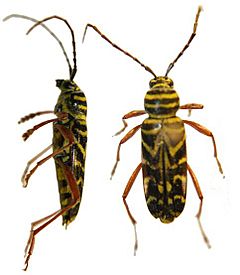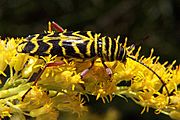Locust borer facts for kids
Quick facts for kids Locust borer |
|
|---|---|
 |
|
| Adult locust borer | |
| Scientific classification | |
| Kingdom: | |
| Phylum: | |
| Class: | |
| Order: | |
| Suborder: | |
| Superfamily: |
Chrysomeloidea
|
| Family: | |
| Subfamily: |
Cerambycinae
|
| Tribe: |
Clytini
|
| Genus: |
Megacyllene
|
| Species: |
M. robiniae
|
| Binomial name | |
| Megacyllene robiniae (Forster, 1771)
|
|
| Synonyms | |
The Megacyllene robiniae, often called the locust borer, is a type of longhorn beetle. It lives only in eastern North America. This beetle is a serious pest for the black locust tree (Robinia pseudoacacia). They often live in the same areas.
Contents
What's in a Name?
The beetle's scientific name, robiniae, comes from the black locust tree. The tree's scientific name is Robinia. This name was given by Carl Linnaeus to honor two French royal gardeners, Jean Robin (father) and Vespasien Robin (son).
How to Spot a Locust Borer
From far away, the locust borer can look like a wasp or a bee. This is because it has black and yellow stripes. It can also be confused with two similar beetles: M. caryae and M. decora.
Size and Markings
Adult beetles are about 11 to 28 millimeters (0.4 to 1.1 inches) long. They have a special W-shaped stripe on their wing covers, called the elytra. Both male and female beetles have dark brown or black antennae. The male's antennae are about two-thirds the length of its body. The female's antennae are about half its body length. Their legs are reddish-brown.
What Larvae Look Like
When fully grown, the larvae (young beetles) are about 25 millimeters (1 inch) long. They are white, strong, and do not have legs.
Where Locust Borers Live
The locust borer is found only in North America. Black locust trees are now used more often as ornamental trees in gardens and parks. Because of this, the range of the locust borer has grown along with the trees. However, it has not spread to other continents where black locust trees have been planted.
Preferred Habitat
You can find these beetles almost anywhere black locust trees grow without protection. They are often more common when goldenrod flowers are also around. Adult beetles like to feed on these flowers. So, they tend to stay in wild fields and meadows.
Life Cycle and Diet

In the fall, female beetles often run up and down black locust tree trunks. They are looking for cracks or wounds to lay their eggs in. Both male and female adults are most active from late afternoon until dusk.
What Adults Eat
Adult locust borers eat pollen from goldenrod flowers.
Larval Development and Tree Damage
The eggs hatch, and the young larvae spend the winter sleeping inside the tree bark. When winter ends, the larvae dig into the tree trunk. They create tunnels that are about 10 centimeters (4 inches) long and 7 millimeters (0.3 inches) wide. These tunnels are a big problem for the tree. They allow a fungus called Phellinus robiniae to get inside. This fungus causes a damaging heart rot disease in the tree. The rot makes the tree weaker and more likely to break in the wind.
Pupation and Emergence
The larvae change into pupae (a resting stage) in late July and early August. New adult beetles start to appear in late August and continue through September. Adults are usually active from August to October.
Why Locust Borers are Pests
The locust borer causes a lot of damage to black locust trees. In the past, these beetles made black locust trees almost worthless in many parts of the United States. If it weren't for these beetles and the fungal infections they cause, the black locust could be a very valuable tree for wood. Young trees grow fast and strong for a few years. But then, they become stunted and sick, and often don't live long enough to be used for timber.
Controlling the Pest
Currently, there is only one product, carbaryl, that is known to work against the locust borer. It is applied once when the adult beetles are most active, usually in August or September.
See also
 In Spanish: Megacyllene robiniae para niños
In Spanish: Megacyllene robiniae para niños

